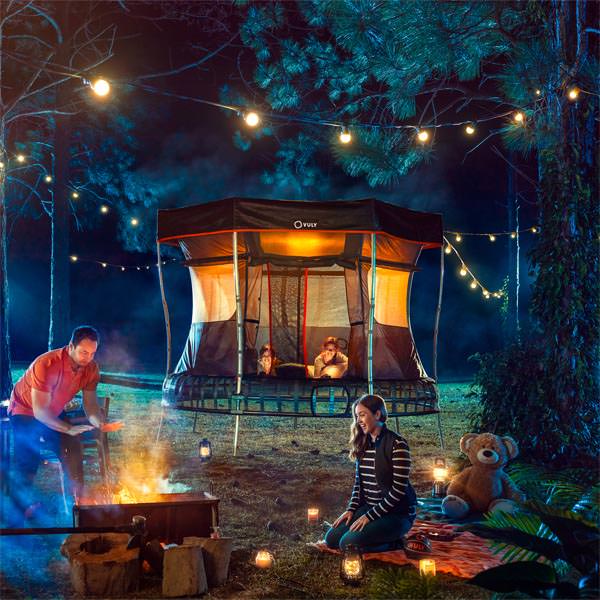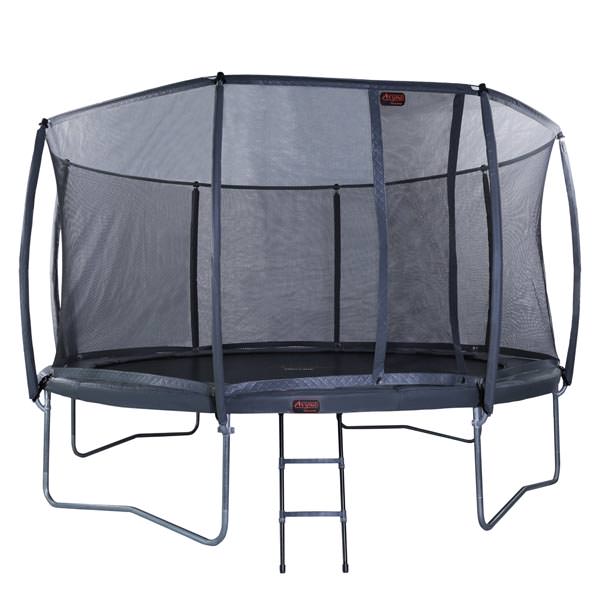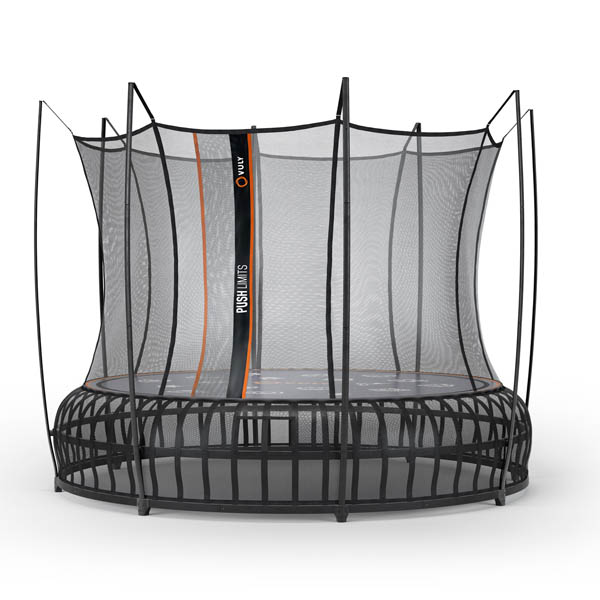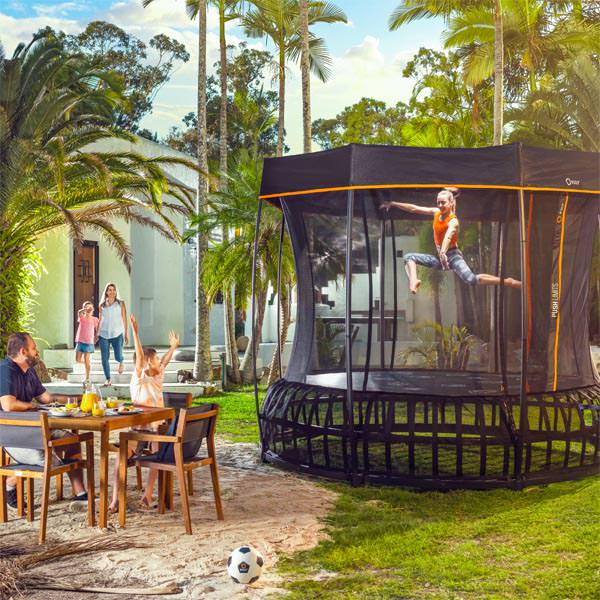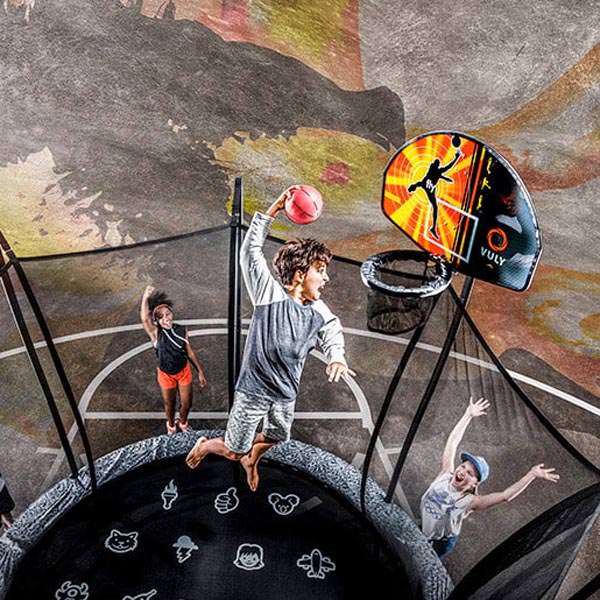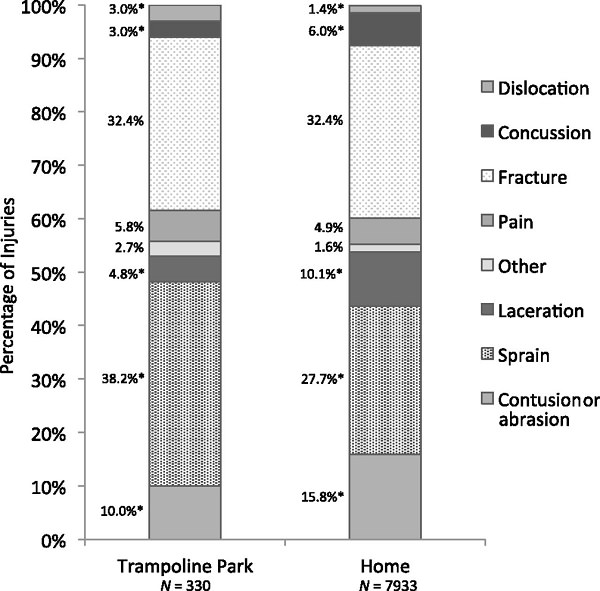How To Buy A Trampoline: The Comprehensive Guide
Buying a trampoline is a great way to keep the family active and provide them with endless hours of entertainment. The great thing about trampolines is that you never really outgrow them. You can enjoy bouncing around on one at all stages of life – and they can even be used for exercise programs!
It’s no wonder that every year 500,000 Americans buy a trampoline for their backyard.
Buying a trampoline seems like it should be an exciting, easy process – right? Well, it’s not that simple. There are a lot of things to consider when choosing a trampoline.
First, there are different shapes of trampolines to consider, various sizes, and numerous safety features that you have to keep in mind. Many of today’s trampolines are also meant to add to your backyard design, which means that there are different features and styles to choose from.
This is why we have created a trampoline buying guide to help you find the perfect addition to your outdoor space. In this guide, we will help you answer some of the most important questions, including:
- What to look for when buying a trampoline.
- What makes a good trampoline.
- How to choose the right size trampoline.
- What makes a trampoline safer.
- Where to put your trampoline.
So, let’s dive in!
Different Shapes of Trampolines
You may not realize that there are several different shape designs for trampolines. Choosing a particular shape design can be advantageous for different reasons, such as the purpose of the trampoline or the size of your space.
1. Round
The traditional trampoline that most of us imagine is round in shape. This is certainly the most popular trampoline shape for many families.
Typically, the smallest outdoor round trampoline is 6 feet in diameter, with enough space for two small children or one adult to bounce. Larger sizes go up to 16 feet in diameter, which is great for a larger number of jumpers.
Are you considering buying a trampoline in this shape? Check out some of our most highly rated ones!
14’ Round Pro-Line Trampoline – This style is designed to be weather-resistant, so it will last for years! It also comes with safety pads, rubber tips, and a full-size net for safety.
Thunder XL Trampoline with Enclosure – If your family takes trampoline jumping seriously, then the Thunder XL is a perfect choice. This model has specialized engineering for better, higher bounces – but it also has built-in safety features for long-lasting fun.
Thunder XL Tent Walls and Shade Cover – If safety, comfort, and privacy are important to you, then the Thunder XL is a great choice. This round trampoline comes with a specially-designed Thunder Tent to shield jumpers from the sun, wind, or rain. You can even use it as a tent for outdoor sleepovers!
Thunder PRO Trampoline Large with Enclosure – If you are looking for the ultimate recreational trampoline, consider the Thunder PRO. This is specially designed for long-lasting performance.
It is the first trampoline to use soft-edging and Leaf Springs, rather than traditional coils. Moreover, it has the world’s highest weight rating of any trampoline on the market!
Advantages of A Round Trampoline:
- Most common and popular shape.
- Many affordable styles.
- Easily enclosed with a safety net to protect jumpers.
- Evenly distributes weights on all springs, so one side does not wear out faster than another.
Disadvantages of A Round Trampoline:
- The round shape tends to force jumpers towards the center, since this is where the surface dips the most. This could cause dangerous collisions and injuries if multiple people are jumping.
- Not enough space for flips and tricks.
- Can only fit a few bounders and is ideal for just one to two people.
Cost of A Round Trampoline:
The cost of a round trampoline depends on its size, safety rating, and material quality. You can typically find a smaller round trampoline for $200 to $900 - and larger trampolines $1,000 to $3,000.
2. Rectangle/Square
Although we are usually more familiar with round trampolines, the first trampolines were actually rectangle. This is also the shape that is used for competitions and in gymnastics.
If you are looking for more space for multiple jumpers or to practice tricks, a rectangle or square trampoline is a better choice.
Advantages of A Rectangle or Square Trampoline
- This shape allows bouncers to stay in place more easily.
- The force of each jump is not evenly distributed, which allows bouncers to control their landings better than on a round trampoline.
- Best for bouncers who want to learn or practice tricks.
- Can be large enough for multiple bouncers to use safely.
- Provide more square footage of jumping pad than round shapes.
Disadvantages of A Rectangle or Square Trampoline
- Uneven shape means that one side may wear down or stretch faster than another.
- Requires larger, heavier frames to hold the trampoline down safely.
- Little difficult to set up, move, and disassemble.
Cost of A Rectangle or Square Trampoline
This shape is often more expensive as rectangular and square trampolines are for professional use. The average square or rectangle trampoline costs between $400 to $2,000.
3. Oval
If you want the even force distribution of a round trampoline but the space of a rectangle, an oval trampoline shape is a perfect compromise. This is considered to be the ideal style if you plan to have multiple jumpers using the trampoline - since they can safely bounce without colliding into each other accidentally.
Oval trampolines are also great for practicing long jumps or flips as there is plenty of space. Most oval trampolines are larger than round ones, typically measuring 10’ x 14’ or 11’ x 16.’
Advantage of Oval Trampolines
- Considered to be one of the safest design with no sharp edges or exposed coils.
- Promotes even wear on all of the springs.
- Elongated shape provides jumpers with more control over their landings.
Disadvantage of Oval Trampolines
- Difficult to find as this shape is less common and popular.
- Does not optimize square footage as well as rectangular shaped trampolines do.
Cost of Oval Trampolines
Oval trampolines are less common than other shapes so fewer retailers offer them. This also makes them a bit more expensive, with prices ranging from $400 to $1,900.
4. Octagon or Polygon
Octagonal or polygonal trampolines are not the most popular trampoline shape, but they can be a great option for many reasons. These shapes are unique because the trampoline has multiple, distinct sides, but the shape of the jumping pad itself generally rounded.
Advantages of Octagon or Polygon Trampolines
- This shape does not take up as much room as square or rectangle trampolines.
- Offers more stability and control than round trampolines.
- No “dead spots” or unexpected catapults with multiple jumpers as the shape helps to balance the jumping force.
- Higher weight capacity than round trampolines. Some models have up to a 450 lbs. capacity, which can accommodate for children and adults.
Disadvantages of Octagon or Polygon Trampolines
- Not very common or popular, so they can be difficult to find.
- Slightly more complicated setups than other shapes.
Cost of Octagon or Polygon Trampolines
Prices for these unique geometric shapes start at $500 and can exceed $2,000 for larger sizes.
How Much Space Do You Have?
Before picking out the trampoline style you want, you also need to consider the shape and size of the area where it will be set up. If you are placing it in your backyard or on a grassy lawn, you will need to first measure the square footage.
It is recommended that there is an absolute minimum of 2 feet of space around the diameter of the trampoline. The ground should be clear of any rocks, plants, or other obstructions. This is to promote safety in case someone falls off of the side of the trampoline.
You must also be sure that there is plenty of space above the trampoline’s jumping clearance. The best rule of thumb is to allow for 24 feet of overhead clearance. There shouldn’t be any branches or roof overhangs nearby the top of the trampoline – just wide-open skies!
So, to determine the size of the trampoline you can fit, you will have to add at least two feet around the entire diameter of the trampoline. Say that you want to purchase a 14’ round trampoline. The best way to measure is to use a measuring tape and secure it to the center point of where you plan to put the trampoline and measure at least 16’ across from all points (14’ plus 2’ of clearance).
How To Choose The Right Size Trampoline
The size of your trampoline should not only be determined by the amount of physical space available. Just because you have a wide-open yard with plenty of room does not mean you need an Olympic-sized trampoline!
Here are some questions to ask yourself to figure out what size trampoline you should buy.
Who will be jumping on it?
The age, height, weight, and athletic abilities of the people using a trampoline should influence the size you are considering.
- Age: If you are purchasing a trampoline for your kids, a smaller size will do. But remember that your kids will grow – so if you plan to keep your trampoline for years, you may want to consider a larger size even if your children are currently youngsters.
- Size: You should also consider the trampoline weight limit when picking out the size and shape. Generally, you want to have at least a few pounds of leeway from the maximum limit. If three 50-lb kids will be jumping, it is best to purchase a trampoline that can support 200 lbs.
How many people will be using it?
Will your trampoline be the main source of entertainment for your kids and their friends? In that case, you will want to choose a larger size so there is plenty of room for them to jump around without bumping into each other.
On the other hand, if you plan to use this solo or will be enforcing a one-at-a-time rule with your kids, you can stick to a smaller one.
How much space do you have in your yard?
The physical space will be the main determining factor for your trampoline’s size and shape. Remember, you want as much clear space as possible around, underneath, and above the trampoline as possible to prevent injuries!
Important Features To Look For When Buying A Trampoline
The key to narrowing down your options when buying a trampoline is to figure out which factors are the most important to you. This will help you eliminate models, sizes, and brands which don’t offer everything that you need and want.
You may want to create a checklist with all of the factors that are absolute needs, some that you would like to have, and ones that are an absolute no-no.
Here are the key factors to consider when looking for a trampoline to buy:
- Shape– Which shape will fit your outdoor space best? Which shapes are you not interested in based on the footage, safety factors, or price?
- Size – What are the minimum and maximum sizes that will fit in your space?
- Weight limit – What is the minimum trampoline weight limit you need to support the total weight of the people who will use it?
- Frame – Consider the frame design, weight, and material. You want to be sure the frame is sturdy so it lasts a long time, especially if your trampoline will be used a lot!
- Springs – Most trampolines have steel springs to connect the net to the frame. However, you can buy trampolines without springs! If you decide to use springs, you can choose between high-tension (limited bounce, firmer net) or low-tension springs (higher bounce, softer landing). Springless trampolines use fiberglass rods, which allow for the same amount of bounce - but without the danger of sharp spring edges!
- Safety Nets – A trampoline safety net is not required, but it is certainly a good idea to add to any lifted trampoline. All of the above-ground trampolines we sell come with a built-in safety net.
- Bottom Attachment – If you are buying a trampoline that does not come with a safety net, consider the way a net will attach to the frame. It is best to use an attachment that creates a seal around the bottom - either with hooks or a heavy-duty rope.
- Jumping Mat – If you expect to use your trampoline a lot or you live in an area with changing weather conditions (heat and cold, rain, snow), then you might want to purchase a high-quality jumping mat. Pay attention to the number of stitches in the mat and opt for “waterproof” styles if you get a lot of rain or snow!
- Paddings – Safety pads cover the side of the trampoline to prevent fingers, toes, or hair from getting caught in the springs. It is essential that this pad fits perfectly over the edges and has a bit of padding in case someone lands on top of it.
- Safety features – There are other safety features you may want to purchase, such as trampoline ladders or an entrance closure. You may also want to add reinforced stitching around the safety net track to prevent rips.
- Price – Of course, the cost of the trampoline will be a major deciding factor. If you can spend more on a higher quality trampoline, you can save yourself money in the long-run. Cheaper designs will not last as long and may need part replacements after just a few years.
- Assembly – Ask yourself how much work you want to put into your trampoline setup. Some designs take just a few hours and don’t require special tools or equipment. However, some are more difficult - and may even require professional assembly.
What Kind of Surface Area is Ideal For A Trampoline
You cannot place a trampoline anywhere you want in a backyard. There are some requirements to promote safety and prevent your trampoline from moving, tipping over, or getting damaged.
- No slopes – The ground needs to be perfect even and flat underneath the frame.
- Soft Ground – There should be a little bit of giving in the soil beneath so the frame legs can settle in for extra support.
- Add lighting – If you want to use the trampoline at night, you may need to install lighting nearby. Just remember that it should not be placed anywhere above the trampoline opening!
- Clear air space above – no head bumping obstacles.
- Clear surrounding space – All of the surrounding space needs to be free of hazards. It is best to have soft grass or dirt to make for a safer landing just in case!
Most Common Trampoline Injuries
When used improperly, trampolines can cause minor and major injuries.
Every year, hundreds of thousands of people are hurt while jumping on a trampoline. According to a report published by the American Academy of Pediatrics, trampoline injuries are the reason for over 100,000 ER visits every year.
Here is a chart of the percentage of trampoline-related injuries.
Common injuries:
- Concussions – These make up 6% of trampoline injuries.
- Head and Neck Injuries – These constitute about 20% of all trampoline-related injuries.
- Broken Bones – 32.4% of trampoline injuries are fractures, typically in the arm, leg, or ankle.
- Spinal – Unfortunately, landing incorrectly on a trampoline can cause serious damage to the spinal column. While serious injuries are less common, repeated compression from jumping or landing on the spine can cause back pain or pinched nerves.
How Do Trampoline Injuries Happen?
- Multiple people colliding – Having too many people on the trampoline is the leading reason for injuries.
- Landing on a spring – If a spring is not covered, it can cause scratches and cuts or pinch the skin between the coils.
- Stunts gone wrong – Performing a flip, cartwheel, or somersault can lead to head and neck injuries or broken bones.
- Falling off the trampoline – The force of falling from the trampoline to the ground can cause bone fractures. This is why having a trampoline safety net and soft-landing area is so important.
Liability
As the owner of the trampoline, you are responsible for the safety of the users. If your children’s friends are injured under your supervision, you could be held legally responsible. However, if the injury is caused by shoddy manufacturing (such as a faulty design or defective part) while the trampoline is under the warranty, the manufacturer may be at fault.
How To Avoid Trampoline Injuries (And Lawsuits)
To avoid injuries, you need to follow the necessary legal safety precautions:
- Limiting the number of people allowed based on size and the trampoline weight limit
- Properly setting up the trampoline on a flat, clear surface
- Keeping up with maintenance (checking springs, fixing tears, securing safety net)
- Keeping the surrounding area cleared
- Making sure children are supervised when using the trampoline
The best rule of thumb is to follow all of the safety recommendations offered by the manufacturer to a tee. Better to be safe than sorry!
Frequently Asked Questions
Do you still have some questions about buying a trampoline? Here are some commonly asked questions we hear from our customers:
How do you maintain a trampoline?
The key to prolonging the life of your trampoline is to keep up with routine maintenance. Regularly check for any signs of wear or rust on the springs or base, as well as tears on the jumping pad and net. If you leave your trampoline set up during the winter, cover the pad with a tarp and brush off excessive snow and ice.
How many years does a trampoline last?
A trampoline that is used fairly regularly and left outdoors year-round will last between 5 to 8 years. But you can extend the life of a trampoline by replacing the pad and springs and taking good care of it.
When's the best time to buy a trampoline?
If you are looking for a low price, you should consider buying a trampoline at the end of the summer and early fall season. This is when stores will be looking to clear their inventory to make room for seasonal items - and they will generally run sales.
What are the benefits of trampoline exercise?
Trampoline jumping can help improve your cardiovascular health, improve your mood, and burn serious calories! A study conducted by NASA concluded that trampoline jumping can help to strengthen your bones and improve blood flow and oxygen consumption. In fact, a few minutes on a trampoline is up to 68% more efficient at burning calories and boosting cardio output than jogging!
Wrapping Up
You may not have realized just how much thought goes into buying a trampoline. You need to consider all of the options to find the one that will fit in your backyard and keep your family safe!
If you have any questions about which trampoline to buy, be sure to check out Family Leisure’s selection! We offer numerous types of trampoline sizes, shapes, and styles.
You can reach out to our team for further advice and information on all of the outdoor furniture and accessories we sell.
What are you waiting for?
Buy a trampoline today and your family will be jumping for joy for years to come!Join the Discussion:
Comments
No posts found

